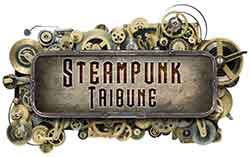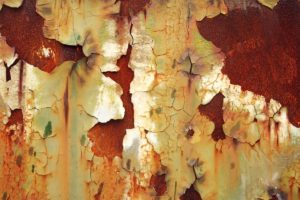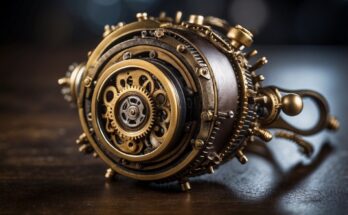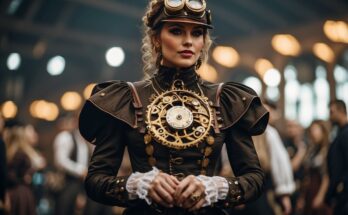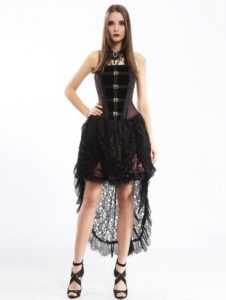Steampunk is one of the most interesting and unique genres and aesthetics out there. Combining influences from Victorian machinery to speculative sci-fi, steampunk seems like an aesthetic that shouldn’t work anywhere near as well as it does.
But if you aren’t familiar with the concept of steampunk, it may seem like a strange and frankly monotonous style. Visually, steampunk uses a lot of muted colors and industrial settings, meaning that vibrant colors are few and far between.

But just because steampunk isn’t colorful on the surface, it doesn’t mean that the genre doesn’t use its color in creative and expressive ways.
If you’re interested in learning more about the use of color in steampunk, you’ve come to the right place.
This article will take you through everything there is to know about the colors of steampunk, from their links to the genre’s influences, to their use in steampunk images, and even some of the different variations on steampunk and the changes in their color palette.
So let’s get started, with this quick guide to color in steampunk images!
The Colors Of Steampunk: An Overview
Steampunk is a genre and art style that sprouted from science fiction. The steampunk aesthetic combines the technology and settings of the industrial revolution of the late 19th century with retro-futuristic machinery and elements of sci-fi and fantasy.
As the name suggests, steampunk heavily features aspects of industrial steam-powered machinery, and iterations of the genre in media such as film, literature, and video games are typically set in the time period they were used (the mid-to-late 1800s).
Steampunk also frequently includes fantastical machines powered by steam, from weapons to airships to mechanical prosthetics. These are linked to speculative fiction of the Victorian era, especially by authors such as H. G. Wells.
Because of its setting, themes, and conventions, steampunk images tend to follow a standard visual aesthetic. The presence of machinery, and steam-powered machinery in particular, mean that metallic colors like brass, copper, and iron are commonplace.
These combine with the colors associated with the time, both literal and figurative.
Dark colors, such as black and various shades of brown, link steampunk to the industrial aspects that inspire it. Steampunk fashion often incorporates leather as a main material, which pairs with metal decorations and accessories.
Lighter shades of brown also tie in with the genre’s setting, although in a more symbolic way; the pale shades of brown and copper help give steampunk imagery a sepia-style tone reminiscent of photographs taken in the Victorian era.
Steampunk as a whole works with a fairly limited color palette mainly consisting of different shades of brown. While other colors are present, particularly in the genre’s offshoots, they tend to be less common and typically only serve as highlights or as a bold contrast.
This doesn’t stop steampunk images from showcasing how unique and interesting the genre is, however, and the way the steampunk aesthetic uses color only serves to strengthen its themes and influences.
What Colors Are Used In Steampunk?
Steampunk as a whole has a fairly set aesthetic. While this can vary between the genre’s various incarnations, the same basic styles have remained mostly consistent.
The original concept of ‘steampunk’ draws from two main influences – 19th-century steam-powered machinery, and retro-futuristic styles from science fiction.
The combination of the industrial revolution with technologies matching or exceeding the modern day has led to several different interpretations, but the overall color scheme has stayed the same.
Classic steampunk, which focuses most heavily on the industrial aspect of the genre, typically uses more muted colors influenced by machinery and Victorian-era clothing.
The predominant colors in most steampunk images are various shades of brown, sometimes accompanied by black or deep shades of red or blue.
Occasionally, metals can also be used to complement the rest of the colors as well as to reinforce the industrial influences.
Brass is usually the metal of choice when it comes to steampunk, although other metals such as iron, copper, or steel can also be found in many steampunk images.

Although most steampunk aesthetics primarily consist of brown tones, don’t think that it makes them boring. Steampunk is anything but monotonous, and it uses its color palette in a diverse way through the use of different shades and materials.
Steampunk fashion is a broad topic, but many steampunk-inspired styles incorporate different colors through various materials to complement each shade and keep things fresh.
For example, the rich color of leather can be paired with lighter tones (such as a white or cream shirt), or darker shades like black for shoes and accessories.
Stark, bright colors can also be used as bold contrasts to make steampunk images and clothing stand out. Crimson and royal blue are popular choices, adding a bit of regal flair.
While other, lighter colors such as purples and greens can also be used, although they are found much more sparingly.
As steampunk as a concept has grown and evolved, different offshoots of the original style have brought many new and varied colors into the mix.
Since its origins, steampunk has found other influences with more vibrant tones that brighten up the whole aesthetic.
Primary colors are used to great effect, with bright reds, blues, and yellows livening up the color palette. Vibrant secondary colors with different shades of orange, green, and purple can also be added to the steampunk palette.
This breaks up steampunk’s original monotony and brings a new element to the genre without sacrificing its industrial and retro-futuristic aesthetic.
How Are These Colors Used?
Color plays a lot into the themes and expression of steampunk, both as a genre and as a style. Because so much of steampunk is based on retrofuturism and the combination of different time periods, it tends to conform to a set color palette.
As mentioned previously, brown is the most common color in steampunk images. This is because of the genre’s industrial inspirations, where brown conjures images of steam engines, rust, and wood.
This is also why metals like copper, brass, and steel are present in steampunk images and fashion – to relate to the technological rush at the end of the 19th century.
From a fashion perspective, various shades of brown are present throughout a steampunk wardrobe. Leather, in particular, is a major component of steampunk fashion, present everywhere from boots to jackets.
Brown trousers and waistcoats are also common, often a different shade of brown to complement the rest of the outfit.
Not everything needs to be brown, however, and a lot of steampunk fashion works other colors in to highlight and contrast.
These can include things like black boots and accessories, or the inclusion of metal decorations worn separately or combined with the clothing itself.
If you’re familiar with steampunk fashion, you might be thinking about people wearing goggles with a top hat – this is a fairly common stereotypical steampunk look.
Some steampunk fashion also includes bright primary colors to further highlight and contrast the rest of the look, and some offshoots have much more colorful ensembles as a whole.
In media such as films and video games, the use of brown and metallic colors in steampunk images is worked into the setting and world-building.
Because of its industrial and retro-futuristic themes, steampunk media often reflects this with Victorian-era settings and steam-powered machinery.
Sci-fi-inspired inventions and weapons are also a recurring aspect of steampunk media, often made out of brass and various machine pieces.
This use of brown and metallic colors builds up the world of the media and helps compliment the other steampunk aspects it has.
Other colors also come into play, depending on the setting and themes of the film or game. Bright colors can be a natural part of the environment, or as a sign of the supernatural – magic, for example, is a common theme in steampunk media and is often represented by bright colors.
Contrastingly, darker color palettes can be used if the film or game leans more into aspects of horror. Some examples of steampunk media are heavily influenced by Lovecraftian horror, and reflect this through black and dark, muted tones.
How Color In Steampunk Has Evolved
Over time, the aesthetics of steampunk have shifted and changed, with entirely new styles springing from the original concept.
This evolution of the steampunk aesthetic has brought with it several variations and new styles that range from slight alterations on classic steampunk aesthetics to radically different styles that still hold true to the genre’s core aspects.

While brown is the color most commonly associated with classic steampunk, some versions of steampunk swap this out for a black ensemble. Gothic steampunk adds another influence into the already spliced steampunk genre – gothic horror.
Gothic steampunk not only darkens its colors. The themes and designs of the subgenre are often strongly linked to aspects of horror, most commonly from sources such as H. P. Lovecraft, Mary Shelly, and Bram Stoker.
In gothic steampunk fashion, brown and other colors are swapped out for black. The clothes themselves are also often more closely related to gothic fashion than industrial influences, and items like corsets, top hats, and overcoats are more common.
However, a lot of the steampunk aspects such as metal adornments and accessories remain. Copper and bronze are still used as highlights against the black and to reinforce the retro-futuristic look, although these might be switched out for iron, steel, and even silver.
Gothic steampunk media also has more of a focus on horror, with films and games being darker both thematically and stylistically.
Other variations of steampunk include aesthetics influenced by alternative themes. Dieselpunk, for example, is an offshoot of steampunk that pushed steam power to the side in lieu of coal- and oil-powered machines.
Dieselpunk often uses greys instead of brown, with iron and steel replacing brass and copper. Another departure from steampunk’s origins is the time period dieselpunk is influenced by.
Instead of the steam-powered industrial revolution of the late 19th century, dieselpunk predominantly focuses on the machines of the 1940s-1950s, especially during the Second World War and its aftermath.
Decopunk is similar to dieselpunk with a few marked differences. As the name implies, decopunk takes its influences from the art deco movement around the same time as dieselpunk (the 1950s).
The gritty diesel-soaked aesthetic is replaced by a sleek and clean look, with lighter tones of brown and gray and chrome replacing the dark steel of dieselpunk.
Some offshoots of steampunk push this further, with plenty of color overshadowing the style’s industrial roots. Atompunk leans more on the futuristic side of retrofuturism, and mimics some of the images from 1950s pulp sci-fi novels.
This leads to the use of lots of bold, primary colors alongside steel and bronze machines. This subgenre tends to forgo elements of steampunk such as the use of steam power, as well as its normal color scheme.
You can also find classic steampunk aesthetics that use more color while still staying true to steampunk’s origins. Inspirations from Art Nouveau and fantasy from the mid-to-late 1800s can give steampunk a colorful twist.
The traditional shades of brown are swapped out for bright and bold colors, with even the mechanical adornments being less industrial and more vibrant.
While these variations have drifted away from some of the foundations of steampunk imagery, they still maintain the aesthetic’s use of retro-futuristic technologies, settings typically around the late 19th century, and the incorporation of mechanical aspects into fashion, film, and other incarnations of the steampunk genre.
Final Thoughts
So there you have it! Steampunk is a fascinating and varied genre, with a multitude of clashing influences melded together.
These odd combinations of inspirations have led to steampunk having plenty of uses for color, despite the aesthetic gravitating mainly towards shades of brown and various metallic colors.
Although the genre’s original use of brown and brass has since evolved and changed to a more colorful style, steampunk’s use of leather, metal, and other industrial imagery means that even more monotonous steampunk imagery stays true to the genre’s setting and style.
Newer iterations of steampunk incorporating more (or less!) color into their aesthetics simply means that the genre will keep on evolving and shifting with every new incarnation.
From the tan leather of classic steampunk to the grimy steel of dieselpunk to the vibrant colors of more modern, Art Nouveau-inspired styles, steampunk continues to use its color scheme to further express the genre’s imagery.
We hope you’ve enjoyed exploring the colors of steampunk. Whether you’re a fan of steampunk yourself or are simply interested in how steampunk imagery uses color, there is plenty to learn and enjoy when it comes to steampunk.
